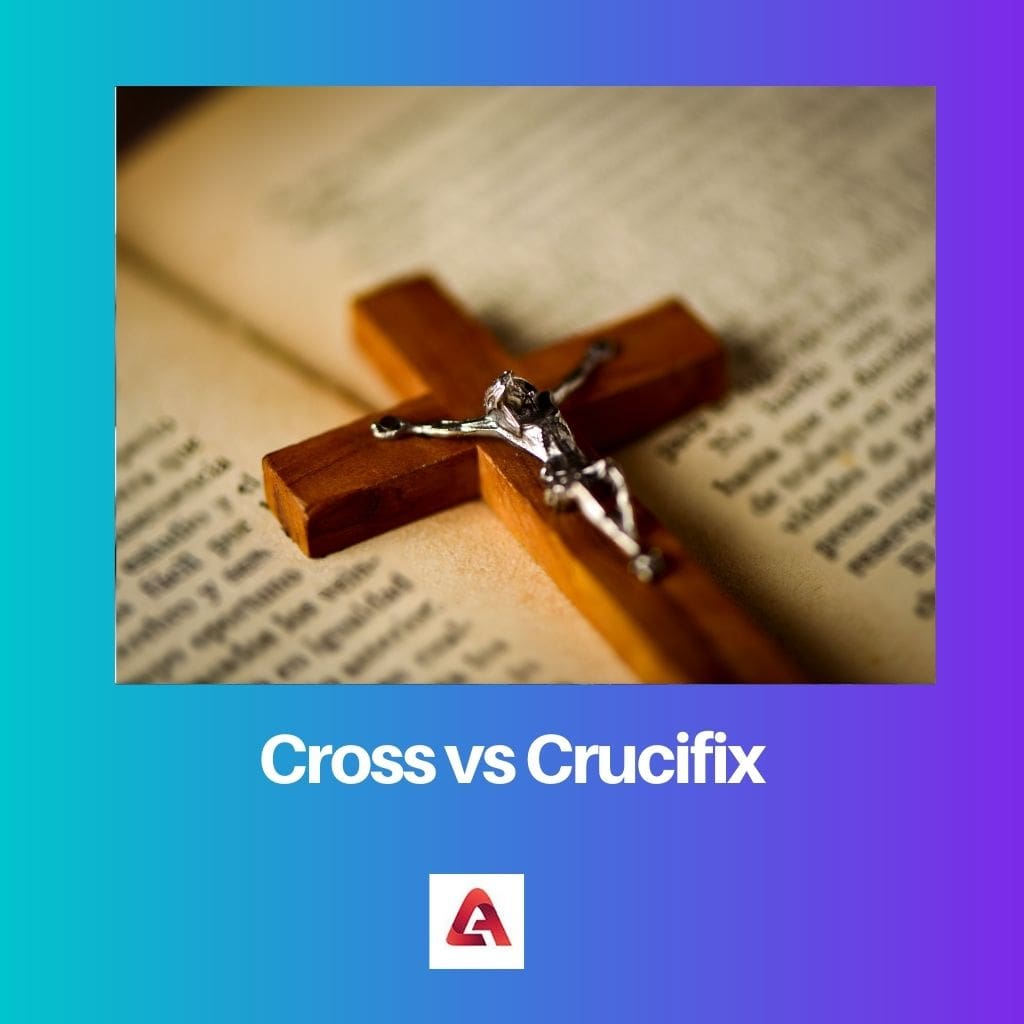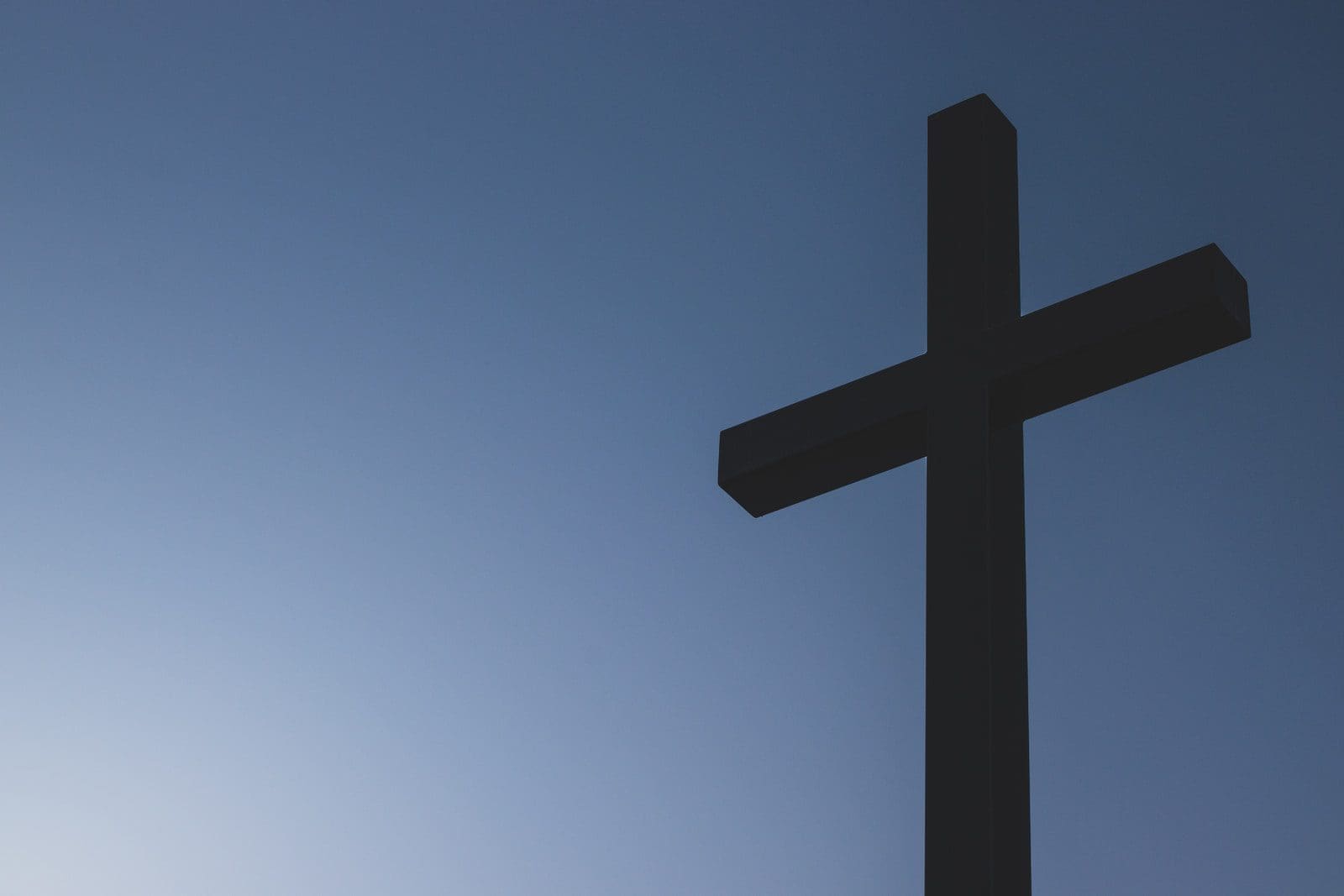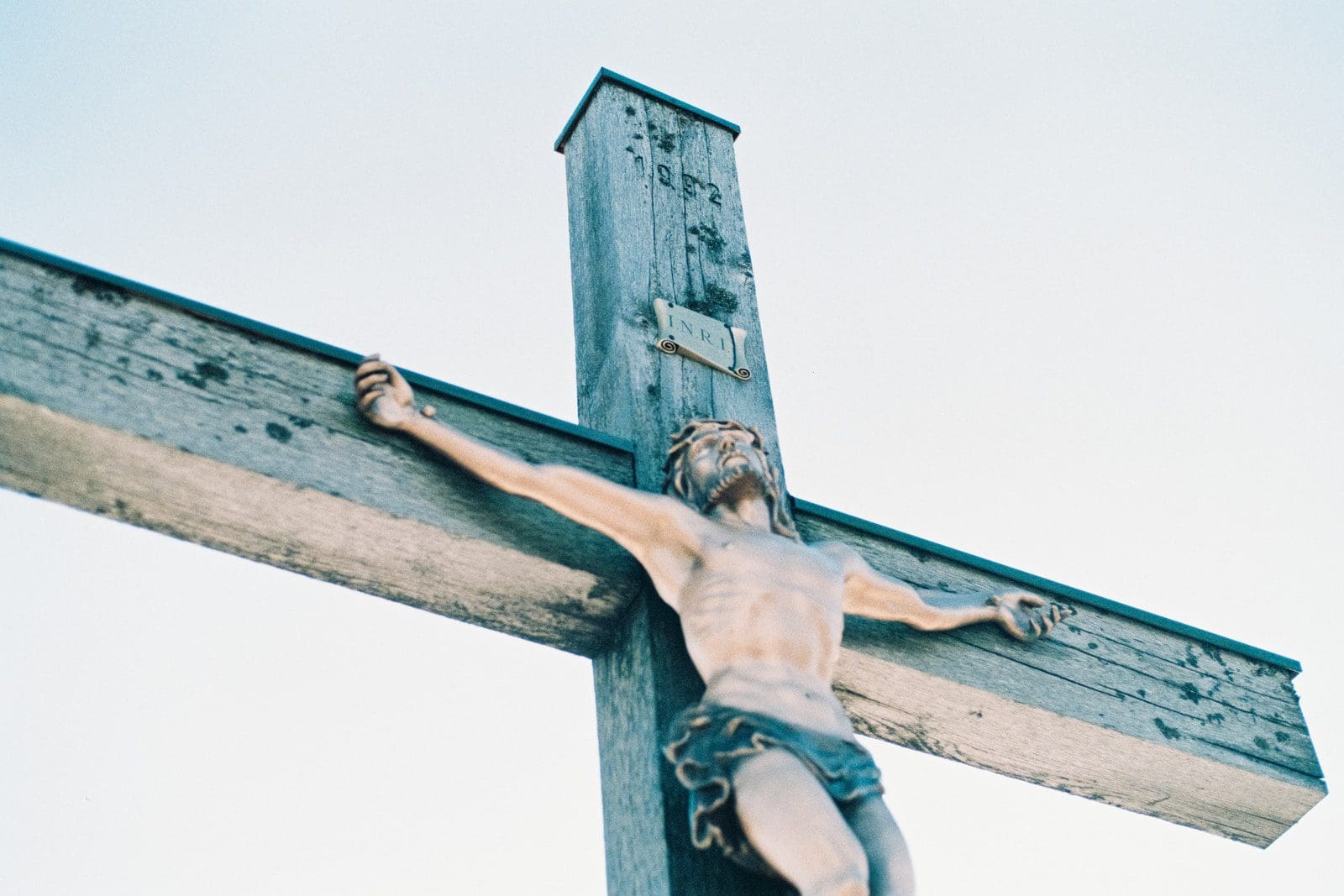A cross is a simple geometric symbol representing Christianity, featuring two intersecting lines. On the other hand, a crucifix is a specific type of cross that includes a depiction of the crucified Jesus Christ, symbolizing the sacrifice and redemption central to Christian theology.
Key Takeaways
- A cross is a symbol with two intersecting lines, representing the instrument of Jesus Christ’s crucifixion. At the same time, a crucifix is a cross with a representation of Jesus’ body (corpus) attached to it.
- The cross is a more abstract and universal symbol used in various religious and cultural contexts, whereas the crucifix is specifically associated with Christianity and the depiction of Jesus’ sacrifice.
- Christian denominations use the symbols differently: the crucifix is more common in Catholic and Orthodox traditions, while the cross is more prevalent in Protestant faiths.
Cross vs Crucifix
The difference between a Cross and Crucifix is that the Cross is a cross-shaped item without a symbol or figure of Jesus, while Crucifix is a Cross with Jesus depicted or engraved on the same.

However, the above is not the only difference. A comparison between both the terms on specific parameters can shed light on subtle aspects:
Comparison Table
| Feature | Cross | Crucifix |
|---|---|---|
| Symbol | A simple two-beam intersecting figure, in the shape of a T or X. | A cross with the figure of Jesus Christ depicted upon it, representing his crucifixion. |
| Meaning | Represents Christianity in general, symbolizing faith, salvation, and sacrifice. | Represents specifically the sacrifice of Jesus Christ on the cross for humanity’s redemption. |
| Emphasis | On the faith and principles of Christianity. | On the suffering and sacrifice of Jesus Christ. |
| Use | Often used in a wider range of contexts, including churches, jewelry, and decorations. | Primarily used in religious contexts, especially for prayer and devotion. |
| Religious Preference | Used by various Christian denominations, including Catholics, Protestants, and Orthodox Christians. | Primarily used by Catholic and Orthodox Christians, with some Protestant denominations preferring the plain cross. |
What is Cross?
Definition of a Cross
A cross is a geometric symbol that consists of two intersecting lines, perpendicular to each other. This symbol has deep historical and cultural significance, particularly within Christianity.
Geometric Characteristics
- The cross consists of a vertical line intersecting a horizontal line at or near the midpoint.
- It can vary in size, shape, and style, but the fundamental structure remains consistent.
- While the equal-armed cross (also known as the Greek cross) is one of the most recognizable forms, other variations exist, such as the Latin cross with a longer vertical line.
Historical Significance
- The cross has been a symbol of diverse meanings throughout history, predating Christianity. It has been associated with fertility, life, the four elements, and various religious beliefs.
- In Christianity, the cross gained prominence as a symbol of salvation and redemption following the crucifixion of Jesus Christ. It represents the central tenets of Christian faith, including sacrifice, love, and forgiveness.
Cultural and Religious Usage
- The cross is widely used in Christian religious rituals, ceremonies, and iconography. It adorns churches, graves, and religious artifacts.
- Beyond Christianity, the cross has been adopted by diverse cultures and religions, sometimes with altered meanings. For example, it’s found in ancient Egyptian hieroglyphs and Hindu symbolism.
- In contemporary secular contexts, the cross is used as a symbol of hope, strength, and solidarity, transcending religious boundaries.

What is Crucifix?
Definition of a Crucifix
A crucifix is a religious symbol that depicts the figure of Jesus Christ crucified on a cross. It holds profound significance in Christianity, particularly within Catholic and Orthodox traditions, serving as a focal point of devotion and contemplation.
Visual Representation
- A crucifix features a representation of Jesus Christ’s body affixed to a cross, with nails piercing his hands and feet.
- The figure of Christ may vary in style and detail, ranging from realistic depictions to more stylized or symbolic representations.
- The cross itself may bear additional elements, such as inscriptions, symbols of the Passion (such as a crown of thorns), or the INRI inscription (Latin for “Jesus of Nazareth, King of the Jews”).
Symbolism and Religious Meaning
- The crucifix symbolizes the central beliefs of Christianity, particularly the crucifixion and subsequent resurrection of Jesus Christ.
- It serves as a powerful reminder of Christ’s sacrifice for humanity’s sins, embodying themes of redemption, forgiveness, and salvation.
- The crucifix is a focal point of prayer, meditation, and contemplation for Christians, inviting believers to reflect on the suffering and love of Christ.
Usage in Worship and Devotion
- Crucifixes hold a central place in Catholic and Orthodox Christian worship, adorning churches, altars, and personal devotional spaces.
- They are used in religious rituals, such as the Stations of the Cross, where believers reflect on Jesus Christ’s journey to the crucifixion.
- Devotional practices, such as praying before a crucifix or wearing crucifix jewelry, are common among Christians seeking spiritual guidance and solace.

Main Differences Between Cross and Crucifix
- Symbolism:
- A cross is a simple geometric shape with two intersecting lines, symbolizing Christianity and the crucifixion but without depicting Jesus.
- A crucifix is a cross that includes a representation of Jesus Christ, in the form of a corpus (body).
- Representation:
- A cross represents the Christian faith and the sacrifice of Jesus Christ.
- A crucifix represents not only the Christian faith but specifically focuses on the crucifixion of Jesus, emphasizing the suffering and sacrifice.
- Iconography:
- The cross is a more neutral symbol, widely used in Christian denominations that may avoid depicting Jesus on the cross.
- The crucifix is a more specific representation, commonly associated with Catholicism and some other denominations that embrace visual depictions of religious figures.
- Denominational Differences:
- The cross is accepted and used across various Christian denominations.
- The crucifix is more commonly associated with Catholicism, Eastern Orthodoxy, and some high-church Protestant traditions.
- Artistic Depiction:
- Crosses can vary in design and style, emphasizing the geometric shape itself.
- Crucifixes include detailed representations of Jesus on the cross, showcasing artistic interpretations of his crucifixion.
- Liturgical Use:
- Crosses are used in various Christian rituals and ceremonies as a symbol of faith.
- Crucifixes may be more prevalent in Catholic liturgy, where the detailed representation of Christ’s sacrifice holds particular significance.
- Cultural Perception:
- Crosses are widely accepted and recognized as a symbol of Christianity, appearing on churches, graves, and religious artifacts.
- The use of crucifixes may be more divisive in certain cultural or religious contexts, as some denominations prefer a plain cross to avoid visual representations of Christ.
- Jewelry and Accessories:
- Crosses are commonly used in jewelry and accessories as a fashion symbol and expression of faith.
- Crucifixes, while also used in jewelry, may be more explicit in their religious symbolism due to the depiction of Christ.

- https://books.google.com/books?hl=en&lr=&id=QiZCSJdG4TYC&oi=fnd&pg=PR7&dq=Cross+and+Crucifix&ots=oPQQ9JfN69&sig=mVnA0k5ofrM5Lcl4–aM-iz0ulM
- https://cadmus.eui.eu/bitstream/handle/1814/29058/RSCAS_2013_88.pdf?sequence=1&isAllowed=y

It’s intriguing how the meanings and uses of the cross and crucifix have evolved over time. This article paints a vivid picture of their evolution.
Indeed. The evolutionary journey of the cross and crucifix is a testament to the enduring nature of religious symbolism.
Definitely. The development and adaptation of these symbols throughout history is captivating.
The distinction between the cross and the crucifix is vital to appreciate their cultural and religious implications. This article does an exceptional job of elucidating these differences.
I couldn’t agree more. It’s essential to recognize the significance of these symbols in Christian theology and tradition.
The article aptly emphasizes the significance and symbolism of the cross and the crucifix in Christian religious practices. It’s comprehensive and insightful.
Absolutely. This piece is a valuable educational resource for those seeking a deeper understanding of Christian iconography.
I think the distinction between the cross and the crucifix is a critical aspect of Christian iconography that goes unnoticed.
Agreed. This article does a wonderful job of highlighting the nuanced differences between these symbols.
The historical and theological analysis presented in this article is indeed thought-provoking. It underscores the rich symbolism embedded in the cross and the crucifix.
Absolutely. The article has provided a well-rounded exploration of these iconic Christian symbols.
Thanks for shedding light on the subtle differences between the cross and the crucifix. I think it’s important to understand the distinctions between the symbols.
I agree. It’s fascinating to see how the symbols are interpreted differently by various Christian denominations.
Yes, you’re right! Understanding the symbolism of these important Christian symbols is crucial for a deeper appreciation of Christian faith.
I appreciate the historical context provided in this article. It’s essential to understand the cultural and religious significance of these symbols.
Agreed. The historical backdrop enhances our appreciation for these symbols and their associated beliefs.
Absolutely. It adds depth to our comprehension of Christian traditions and practices.
I never realized the depth of meaning behind the cross and the crucifix. This has been a truly enlightening read.
Absolutely, the historical and religious significance of these symbols is quite profound.
The comparison table was particularly illuminating. It provided a clear and concise breakdown of the divergences between the cross and the crucifix.
Yes, I found that part very informative as well. The visuals and textual comparison were quite valuable.
The cross and crucifix serve as powerful symbols with deep significance. Understanding their distinct meanings enriches our comprehension of Christian symbolism.
I concur. The nuanced differences between the cross and the crucifix deserve careful consideration to fully grasp their symbolism.
Absolutely. This article provides valuable insights into the historical and religious implications of these symbols.